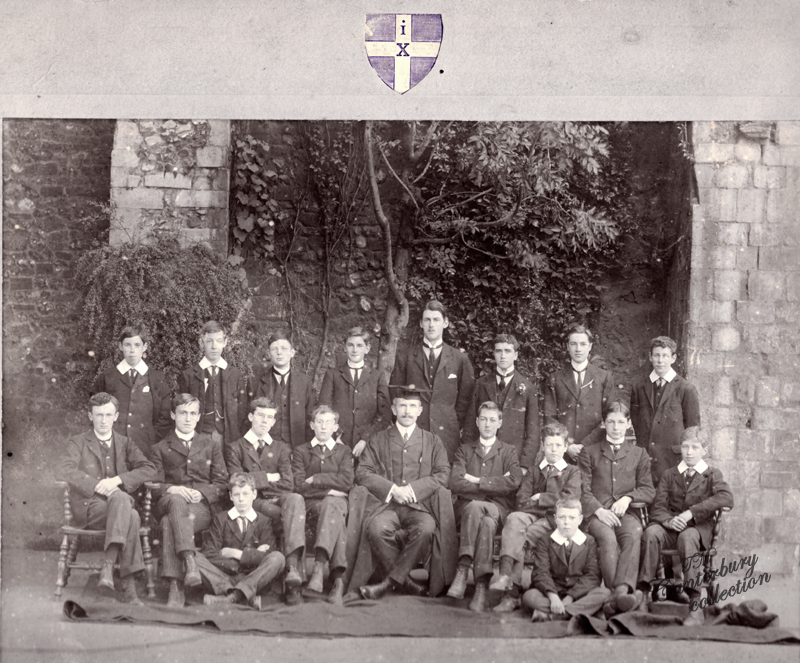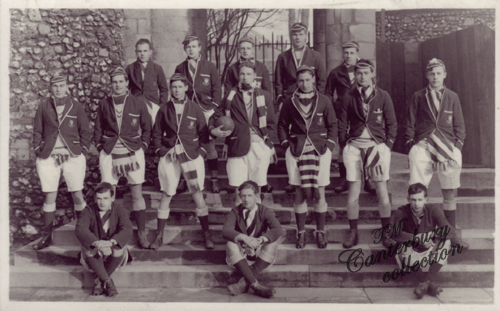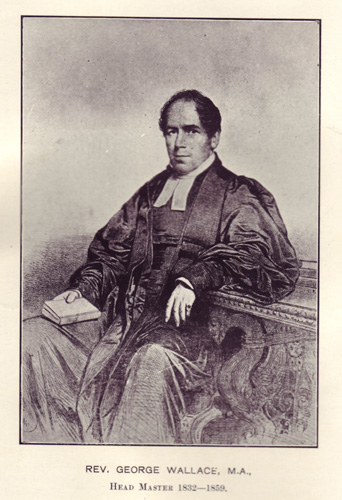
![]()
~ THE KING'S SCHOOL ~
CANTERBURY
OLD MINT STREET, MINT YARD
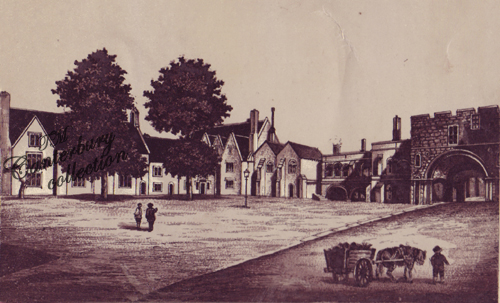
"The King's School at Canterbury was founded by King Henry the Eighth, who, by the Charter of Foundation, which he granted in the Thirty-third year of his reign, 1542, to The Dean and Chapter of The Cathedral Church of Christ, constituted the School a part of it, to consist of a Master, Usher, and Fifty Scholars, who were to eat at the Common Table, but which the provision made by His Majesty for that purpose could not, however, long maintain."
"Brookland - Rev. Mr. John Leahunt. May 13th, died, Rev. Mr. John Lehunt, master of the king's school, at Canterbury, and vicar of Brookland, in Kent, by a fall from his horse."
Kings School Scholars c?
The King's Scholars are elected, according to merit, at the November Chapter by The Dean and Chapter and the Head Master, out of those boys who have been some time at the School, to supply such vacancies as may happen in the ensuing year, and must be between the ages of nine and fifteen; an exception, however, to this is made in favour of Choristers from The Chapel Royal and Canterbury Cathedral. They may remain at the School, four years, or, with the approbation of The Dean and Chapter, and Head Master, five years, but no longer. After election they are admitted by The Dean.
The School is liberally open for Children "from any part of the Kingdom."
The present School-house seems to be what was once the old Chapel of St. Thomas the Martyr, and the Head Master's House, what was the lodgings of the Chantry Priests.
The Eton Grammars are used; and the Eton plan of Education is pursued.
The Benefactions in favour of the Scholars
of this School are numerous:
In 1625, William Heyman, of Canterbury, Gentleman, by Indenture, vested 27 acres of Marsh land in the Parish of Warehorne, in the County of Kent, in certain Feoffees, to apply five parts out of six of the rents of those premises upon Two poor Scholars only, to be placed in The King's School at Canterbury, to be nominated by his next heir and the majority of the Feoffee; such Scholars to be descended from the body of his Grand-father, Peter Heyman, Esq., or to be natives, or born of such as are natives of Sellinge. The Scholar so to be chosen, to be full eight years old; who should hold his Exhibition for nine years, and if he should go to any College in Cambridge, to be continued for seven years from his leaving School; and if he should take Orders in the first five years of the seven, the same to be continued to him for three more years more, that is ten in the whole, at the University."
A Concise Description of the Endowed Grammar Schools in England and Wales 1818
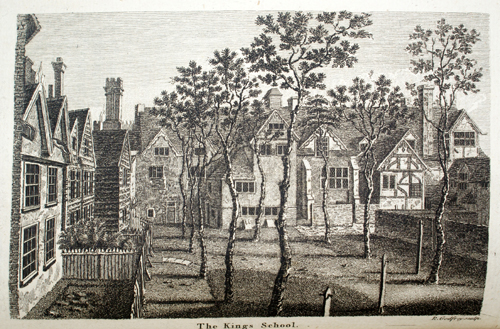
1807, Rev. J. Francis, M.A. 2d Master of the Kings School, Canterbury
December 21. Aged 56, Mr. Robert Naylor, of the Classical Academy, College Green, Bristol, and formerly of Lincoln College, Oxford. He was son of Rev. Christopher Naylor, for many years Head master of King's College, Canterbury. The Gentlemen's Magazine Jan 1823
King's School scholars standing on the Norman Staircase c. 1921+
*the stairs were re-done sometime before the unveiling of the War Memorial 1921 (thanks to Paul for this info)
"Perhaps one of the oldest schools of which anything is known is the school of Canterbury. Theodore, who was consecrated archbishop of Canterbury in 668 (according to some authorities), founded a school or village by licence from the pope. This school certainly existed for a long time; and there is a record of a suit before the archbishop of Canterbury in 1321, between the rector of the grammar-schools of the city* (supposed to be Theodore's school or its representative) and the rector of St. Martin's**, who kept a school in right of the church. The object of the suit was to limit the rector of St. Martin's in the number of his scholars. This school probably existed till the Reformation, at least this is the time when the present King's school of Canterbury was established by Henry VIII., and probably on the ruins of the old school. Before the Reformation schools were also connected with chantries, and it was the duty of the priest to teach the children grammar and singing. There are still various indications of this connection between schools and religious foundations, in the fact that some schools are still or were till lately kept in the church, or in a building which was part of it." Penny Encyclopedia of the Society for the Diffusion of Useful Knowledge 1841
*Ranulph, rector of the grammar schools of the city
**Robert, rector of St. Martins (the school of St. Martin's was kept by "the Parson of St. Martin's, as Somner says "in right of the church and by concurrent custome." Ranulph opposed this right**
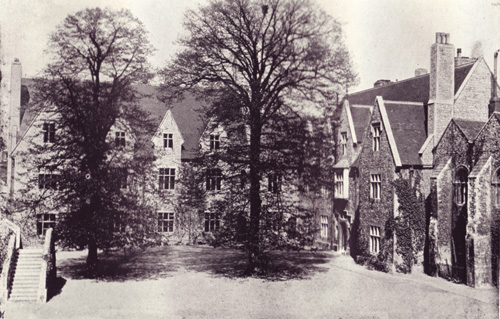
"Civil Promotions - Rev. W. P. Jones, M.A. of Pembroke College, Oxford, Under Master of the King's School, Canterbury, vice Rev. John Francis, resigned." The Gentlemen's Magazine 1821
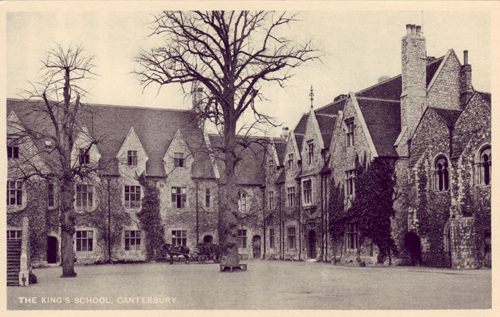
1847 Mr. Anby Beatson, M.A., second Master King's School, Mint Yard
The Quarterly Journal of Education 1835
....The school yet continues according to the terms of Henry's appointment. The upper master has a salary of 100l. with a house capable of accommodating a large number of boarders. The under master has a smaller salary, with a sufficient house. Both are graduates of the English Universities, and clergymen. The former is elected by the dean and chapter, and the latter is nominated by the upper master. The scholars are elected by the dean and chapter, with a stipend of 1l. 8s. 4d. and hold their scholarships five years, their education being cost free. There are likewise two scholarships for relations of the family of Hayman, of which we shall speak in our account of the exhibitions belonging to the school. The instruction is classical and mathematical. Many eminent individuals have been educated here, of whom it will be enough to name Dr. William Harvey, the discoverer of the circulation of the blood; Lord Chancellor Thurlow, Lord Chief Justice Tenterden, and Dr. Herbert Marsh, now Bishop of Peterborough. It was formerly for a long time resorted to for education by the sons of the gentlemen of the county; and, from the character into which it is at present rising, it may be presumed that it will at no distant date be their chief place of education again. "Of the masters," says Hasted, the historian of Kent, 'who have presided over this school, many of them have been men of eminence, as clergymen and scholars; one of them I can mention of my own knowledge, and whoever knew him will join in this tribute of justice to his memory, I mean the Rev. Dr. Osmond Beauvoir, late head master of it, first educated here, and afterwards at St. John's College, Cambridge; whose great abilities brought this school to the highest degree of estimation; who united the gentleman with the scholar; one whose eminent qualifications and courtesy of manners gained him the esteem and praise of all who knew him, many of whom are still living to attest it, and regret the loss of him. He died in 1789.
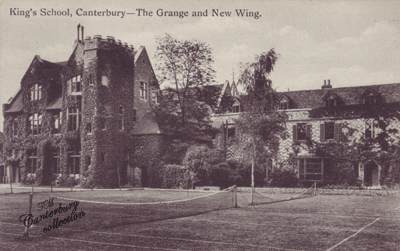
King's School Canterbury - The Grange and New Wing - a postcard from my collection
Death, May 11. At Faversham, Kent, aged 58, the Rev. John Birt, D.D. Vicar of that parish, and Master of the Free Grammar School. He was a native of Gloucester, and a Member of Christchurch, Oxford, M.A. 1812; was formerly for many years Head Master of the King's School at Canterbury; and was appointed to the vicarage of Faversham in 1832 by the Dean and Chapter of Canterbury. He was for some years one of the guardians of the parish, and also one of the charity trustees, and was always ready to exert himself for the benefit of his parishioners. The Gentlemen's Magazine 1847
Death, December 30th, At Canterbury, aged 85, Caroline, widow of John LeGrand, esq. daughter of the late Rev. Christopher NAYLOR, Head Master of the King's School. The Gentlemen's Magazine 1854
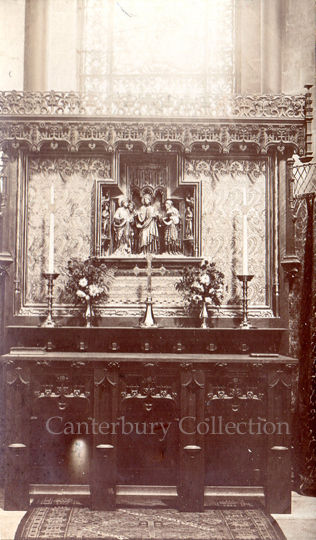
King's School Canterbury - the Kings School Chapel, Canterbury Cathedral - a postcard from my collection
Promotions - Rev. J. Mitchinson to be Head Master of the King's School, Canterbury - The Annual Register, 1860
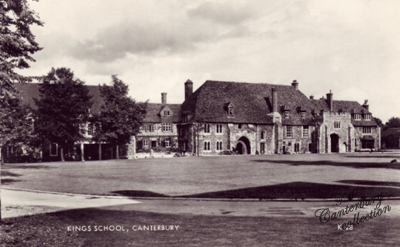
King's School Canterbury - a postcard from my collection
The Rev. John Mitchinson, M.A., Head Master of the King's School, Canterbury
The Rev. J. B. Kearney, M.A., King's School, Canterbury
Local Board for Canterbury, Journal of the Society of Arts, February 3, 1860
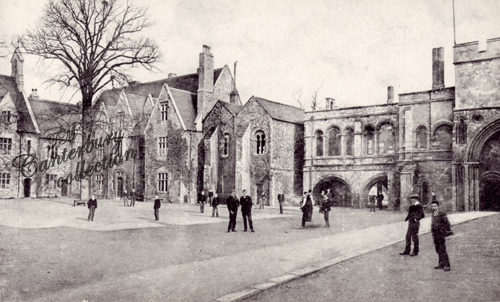
King's School Canterbury - a postcard from my collection
The King's School situated in the Mint Yard, may justly claim to be the oldest of our English Public Schools. It is certain that Archbishop Theodore, in the 7th century, founded a school within the City of Canterbury wherein he placed professors of all the liberal sciences, and there is no doubt that Canterbury was the great centre of learning at least 200 years before King Alfred is said to have founded the school at Oxford. The present school, refounded by Henry VIII. in 1541 for 50 King's scholars, formed an integral portion of the Cathedral foundation. It was re-organized in 1879 by the Charity Commissioners. 1899
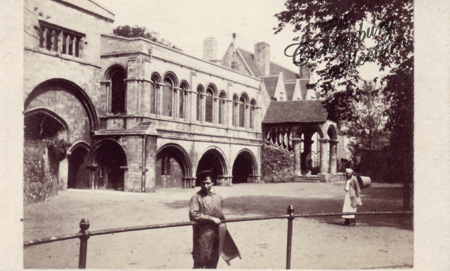
The Norman Staircase, the old monastic almonry (1860's), a photograph in my collection
"The King's School, situated in the Mint yard and approached by the celebrated Norman staircase, claims to be the oldest public school in England, having been in existence in the days of S.S. Ethelbert and Augustine, but was refounded in 1541 by Henry VIII. for 2 masters and 50 king's scholars, forming an integral portion of the cathedral foundation. Among the eminent men whom it has produced are Christopher Marlowe, the dramatist; Richard Boyle, "the great Earl of Cork"; William Harvey M.D. the discoverer of the circulation of the blood; Archbishop Winchelsey, of Canterbury; Accepted Frewen, Archbishop of York (1660-64); Wm. Somner, the antiquary & historian of Canterbury, auditor of the cathedral; the Rev. William Gostling M.A. minor canon; Archdeacon Denne, Sir Samual Brydges bart. M.P. Samuel Pegge, antiquary; Bishops Boyle of Cork (1660-63), Gunning of Ely (1675-84).....etc.
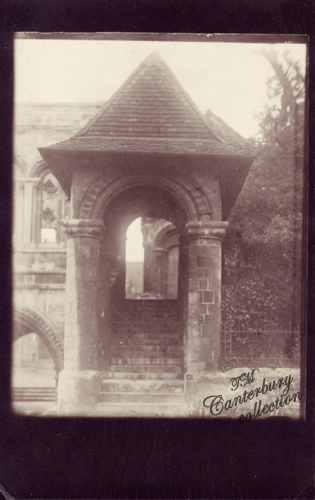
The Norman staircase - a photograph from my collection
A history of the school was published in 1865 by the late Rev. J.S. Sidebotham M.A. (d. 1901). The school was re-organised by the Charity Commissioners in 1879, & has a yearly endowment of £1000. The 50 king's scholars are divided in 25 probationers (£10 for two years), 15 junior (£15 15s. for 5 years) & 10 senior scholars (£25 for 3 or 4 years); there are also 2 Heyman Scholarships of £20 each, founded in 1625, tenable for 4 years at any school, but limited to the kin of P. Heyman, or in default to natives of Sellinge, Kent; 4 exhibitions of £50 a year, tenable for 4 years at Oxford or Cambridge; 2 exhibitions of £50 a year, founded by Archbishop Parker in 1569, tenable with a foundation scholarship at Corpus Christi College, Cambridge, the Bunce exhibition of £50 a year, tenable for four years at Oxford or Cambridge......etc.
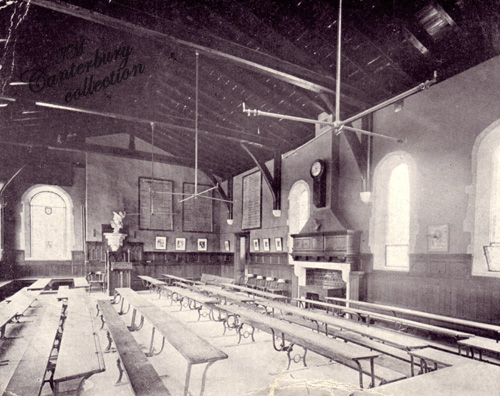
A classroom of the King's school from an old postcard in my collection (The Big School)
There is a junior department for boys 7 to 13, erected in 1881, at a cost of £3000, granted by the Ecclesiastical Commissioners in consideration of £1000 being raised by subscription and expended on the then existing portion; they also granted to the school portions of the old archiepiscopal palace and grounds; this addition provides room for 60 to 70 additional boys & 32 boarders; a gymnasium and three new fives-courts have also been added. Close to the school is a cricket ground and lawn tennis courts, and in addition to these there is a large cricket and football field; the school also maintains a boat club, bicycle club and natural history and musical societies, a museum and a good library and reading room.
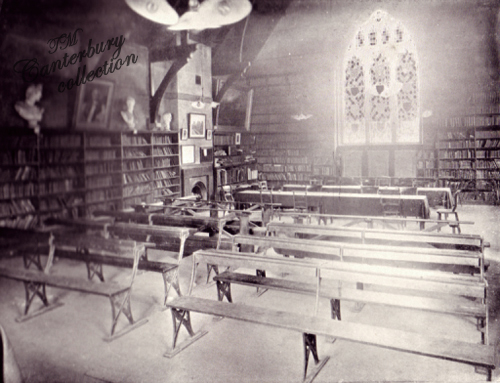
Died at Canterbury, The Rev. Chris Naylor, head master of the King's School, and one of the six preachers of the Cathedral, 77. - The New Monthly Magazine 1816
At Dr. Birt's resignation in November of 1832, Mr. Wallace had been lower master for about eighteen months.
Of the King's School
I find myself accused (too justly I fear) of saying, in my former edition, less of this school than one who was educated at it, and a King's Scholar, ought to have done.
I must endeavour to make amends by the best account I can give of this ancient and royal foundation.
The latter of these titles I can trace no farther than King Henry VIII. who new modeled the establishment of our cathedral; and by whose statutes, as corrected, explained, and confirmed by King Charles I. both that, and its school are regulated.
As to the former, Canterbury perhaps need not give place to any nursery of learning in the whole kingdom.
Archbishop Theodore (according to Lambert in his Preambulation of Kent) by licence of Pope Vitalianus, who died anno domini 669, founded within this city a school or college, wherein he placed Professors of all the liberal sciences. If so, here was, in effect, what we call an University more than 200 years before King Alfred founded that at Oxford, anno domini 886.
How eminently Canterbury was the seat of literature many hundred years ago, appears by the history of the noble Aldhelm, who came hither from the court of Ina, king of the West Saxons, (whose nephew he was), to study under Adrian, abbot of St. Augustine's and who was no less distinguished by his learning than by his rank; being, as he himself boasts, the first who introduced the study of Latin poetry into his country. See Dr. Gale's Scriptoria XV. Vo. I. page 342. He died bishop of Shirborn, anno domini 709, as Bede tells us, page 244 of that volume.
That Augustine settled a school here very early can hardly be doubted. Mr. Somner has given an account of a suit in 1321 between Radulph rector of the grammar schools of the city of Canterbury, and Robert rector of St. Martin's near Canterbury, and of the schools there; when sentence was given in favour of Radulph, reserving to Robert the right he claimed as immemorial of teaching at St. Martin's, but restraining the number of his scholars to thirteen; which may be best accounted for, by supposing this the number of those instructed at St. Augustine's school there, and thus fixed in respect to his memory......
King Henry VIII. founded this school for a master, usher, and fifty scholars; who were to eat at the common table, which the provision made by him for it could not long maintain. The fifty scholars are elected only at the November chapter, as many as may supply the vacancies of the ensuing year: they must be between the ages of nine and fifteen; they receive each a stipend of 1l 8s 4d a year; and hold their scholarships for five years. Besides this there are two scholarships for relations of the family of Heyman; of which, and some scholarships in the University of Cambridge, to which the scholars from this school have a title, a larger account will be given in the next chapter.......
A complete list of the honourable and illustrious families who have sent their sons to this nursery, or of others, less distinguished by birth and fortune, whose own parts and industry have raised them from hence to high posts in church and state, would be a valuable ornament to a larger and more pompous work than I should venture to undertake; but it would be unpardonable to omit mentioning one of those heroes in learning, of whom any school and nation might very justly be proud. I mean the famous Dr. William Harvey, whose important discovery of the circulation of the blood in animals, has given new light to the study of medicine, as well as that of more sublime philosophy which teaches us to admire and adore the wisdom of God in the creation.
1831
Civil Preferments. J. Wallace*, esq. to be second Master of King's College, Canterbury. The Gentlemen's Magazine July - Dec 1831 *should be G. Wallace
There were 62 boys in the school when Mr. Wallace succeeded Dr. Birt.
Rev. George Wallace, M.A., Headmaster 1832 to 1859
*was a death of a George Edwin Goulbourne Wallace in 1859 in Croydon
(there is a note re: birth of a son to Rev. George Wallace of Canterbury - Dover Telegraph Oct 26, 1850)
"George Wallace (M.A. Dec. 29, 1832) was of Trinity College, Cambridge, B.A. 1831, and commenced M.A. in that University 1836. He is, we believe, Head Master of the King's School, Canterbury, to which office he was appointed in 1833." The Gentlemen's Magazine 1864
1851
Augustus Temple, King's Scholar *son of William Temple rector of St. Alphage & Vicar of St. Mary Northgate, Canterbury *living at 10 St. Alphage Lane
1858
Rev. George Wallace, M.A. - Head Master
A. Beatson, Esq. M.A. - Second Master
Thomas Jones - Organist, &c.
Annual Register 1859, Rev. J. Mitchinson to be Head Master of the King's School, Canterbury.
1859, The Literary and educational year book
King's College, Canterbury
Founded by Henry VIII. 1519.
Head Master, Rev. John Mitchinson, M.A.
2nd and Math. do, Andby Beatson, M.A.
Do. Special Dept. Rev. T. B. Kearney, M.A. *J or T?
Feb 3, 1860
The Rev. John Mitchinson, M.A., Head Master of the King's School, Canterbury
*New and standard Educational Works...Rudementary Rules, with examples for the use of Beginners in Greek Prose Composition. By John Mitchinson, D.C.L., late Head Master of the King's School Canterbury, (now Bishop of Barbados). 1861
1861 Assistant Master's
Rev. J. B. Kearney, M.A.
W. Denton Attwood, M.A.
Jules Martinet, B. es L., French
Reinhold Rost, Ph.D. Hebrew and German
L. L. Raze, Drawing
1862 - Marriage, April 1862, at South Shields, of John Streatfeild Lipscomb esq., M.A. Second Master of the King's School Canterbury, to Frances, third dau. of Thomas Salmon esq., of South Shields, (Durham). (The Gentlemen's Magazine 1862) *was age 30 in 1862, born Hastings, Sussex...died in 1871 at the age of 39, his widow Frances was living in Palace street in 1871 with their two sons
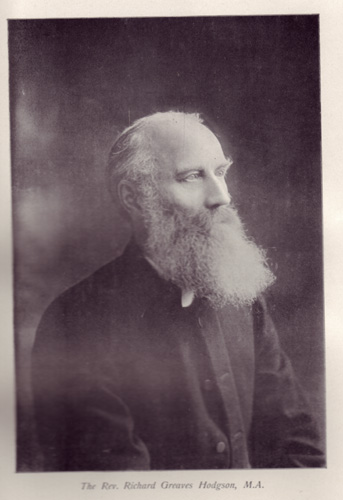
Rev. Richard Greaves Hodgson
*death June 22, 1840, in his 70th year, Richard Greaves Hodgson, esq. of Ashfield, near Manchester ( his family? grandfather)
To the Rev J. S. Sidebotham
24th November, 1865
Dear Sir,
In thanking you for your obliging letter and its accompanying little book, allow me to assure you that I never was at the King's School, Canterbury, and that if there be any resemblance between David Copperfield's Doctor Streong and the Doctor Birt whom you mention, it must be purely accidental, inasmuch as I never before heard of the existence of the last named gentleman.
Faithfully yours, Charles Dickens
1872
Rev. J. Mitchinson, D.C.L. Oxon, Head Master
Assistant Masters
R. G. Gordon, M.A. Oxon
Rev. R. Hodgson, B.A. Oxon
W. J. Oliver, B.A. Camb.
French - Jules Martinet, B.L.
German - H. W. Russell, B.A. Lond.
Drawing -W. A. Boone
Singing - T. Plant
Drill - Sergeant Ray
Fees. 15 guineas per annum (obligatory). Certain subjects are optional.
Scholarships - (a) 25 probationers are elected for 2 years, who receive 10l. 4s. 8d. per annum; 10 senior scholars receive 30l. per annum; 15 junior scholars receive 15 guineas per annum for 5 years. (b) 2 scholarships of 20l. limited to the kin of Peter Heyman or natives of Sellinge, Kent
Board - H.M., 50 guineas per annum; 2nd M., 40 guineas per annum; exclusive of school fees. Three Dame's houses on lower terms.
Library.
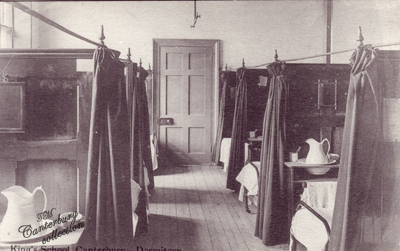
Kings School, Canterbury, Dormitory...from my collection
1886 Rev. E. J. Campbell, M.A., King's School, Canterbury *Member of the Kent Archaeological Society
1891/92, East Kent Natural History Society - Members - Rev. T. FIELD, M.A., King's School Canterbury
1901
Arthur John Galpin, Clergyman and head of King's School
Frances Elizabeth Gadd, Matron
Harriet Spilsbury, Matron
Leslie G. Harrington, Assistant Master
Charles William Bell, Assistant Master
Algernon Latten, Assistant Master
George Easter Vaughn Austen, Assistant Master
Edward Percival Guern, Assistant Master
George Frederick Jenner Rosenberg, Assistant Master
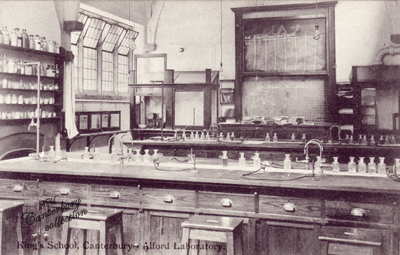
Kings School, Canterbury - Alford Laboratory from my collection
Student's of King's College
Nigel Adam Bittleston * son of George and Edith Bittleston, George was a Captain in the Royal Artillery
He was a Captain in the 2nd Suffolk Regiment in WW1
London Gazette - The Suffolk Regiment - Nigel Adam Bittleston, in succession to Lieutenant F. S. Cooper, promoted. August 28, 1906
*was in Montreal, Canada in 1927 and arrived back in Liverpool, England in July of that year
Frank T. Spickernell, son of Frank and Annie Spickernell. Frank is a Bank Manager in Hythe, Kent. *married 1925, was in New York, USA in 1928.
Basil St. Wilfred Saunders *Lewes, Sussex, son of Clement and Edith Saunders
John A. S. Aylward
Sidney C. M. Archibald
Donald Victor Bacon
Stuart U. Bailey
Geoffrey T. Baker
Edward K. Barber
Ceril E. O. Bax
Arthur G. Blackford
Sydney Francis Bresrey *Forest Gate, Essex
Arthur Norman Brown *born Shanghai, China
Walter G. Campbell
Rabodo E. R. Dalwigk
John R. S. Davenhill
Arthur S. Davenhill
Alfred Richard Davies
John Deighton
Lionel Henry Derne
Harold Stokes Digges
Tom Douglas Dixon
Christopher J. Galpin
Austin Gardner
William J. Gianella
Cecil Leonard Gianella
George W. Godwin
Harold Ernest Green *of Canterbury
Henry Martin Griffiths
Ralph Ashton Hamlyn
Archibald DeBurgh Hanietton *born Florence, Italy
Frederick A. A. W. Heaton
Bernard Leslie Hooper
Raymond de Montgomery Hume Henderson
Benjamin Wright Hunt
Charles William Hunt
Oliver Francis Huysha *born Eintrone Minster, Dorset
Henry Archibald Jenkin
Francis H. Langhorne
Shelton H. L Langley
George C. Laughton
Arthur Cuthbert Lock
William Harold Lovatt
John M. Mackinson
Christopher M. Maltby
Paul Copeland Maltby
Reginald Mannering
George Harold Mansfield
Alfred G. McCulloch
James Arthur McCulloch
Douglas Crostie Kingsford McCulloch
John Harry Meers *born Blackheath, London
Geoffrey H. Mercer
Bruce Eardley Money
Kenneth Moore
Cyril Munn-Mace
Cecil Fosbery Nation
Reginald Fostery Nation *born Nevada, USA
Edward Rottesdon Palmer
Harold Graham Paris
Robert Cohen Paris
Oliver Buxton Parsons
Oswald Duncan Pearce
John Rowland Powell
William R. Poyton
Herbert Jullion Prest
William H. St. L. Redpath
Edward Parish Berryman Richardson
William C. Rubie
Norman C. J. Saunders
Reginald G.W. Saw
Frederick G. L. Scott
Frederick Albert Silk *born London
Sidney S. Sopwith
Geoffrey C. Strahan
Francis Rosborough Stawker *born Lahore, India
John Frederick Swinford
James Walker Taylor
Edward George Teasdale
Arthur Charles Thomas *born London
Archer Noel Trimmer
John Melville Tuke
James Robert Tullock *born London
John Twells
Reginald Watson
Ralph Douglas Weston
Frederick W. C. Wilkins
Walter Beauchamp Loveband Yarburgh
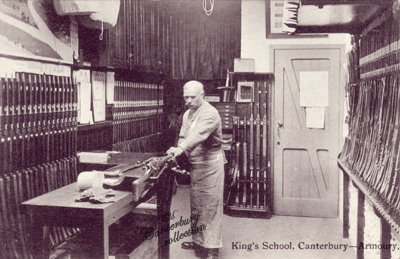
Kings School, Canterbury...Armoury from my collection
1903
Rev. Arthur John Galpin M.A., Head Master, late senior scholar Trinity College, Oxford
Rev. Richard Greaves Hodgson M.A., Master of the Junior Department, late junior student of Christ Church
Assistant Masters
Rev. Leonard Hugh Evans M.A.
Charles William Bell M.A.
Edward Percival Guest M.A.
A. Latter M.A.
J. M. Edmonds M.A.
G. E. V. Austen M.A.
G. F. J. Rosenberg M.A.
H. J. Cape B.A.
Hamilton Baly M.A.
Percy Godfrey Music Bac.
William G. Price
Professor Doret (Gustav Hilerion Doret) Professor of Languages in Maidstone in the 1890's D. Gastave H. Doret d. 1916 Maidstone
Gustave Hilarion Doret, Boulogne France / Gustavi Hilanora Doret married Emma Wood in Harrietsham, Kent in the early 1900's
George F. Heys (*teacher of drawing) in Ramsgate in the early 1900's
Rev. Leslie Goff Harrington, M.A. (Assistant master, King's school) The Precints
Percy Godfrey, Bachelor of Music, Assistant Master at the King's School (27 Palace Street
1905 AD

1907
King's School, Canterbury - The following elections to scholarships have recently been made:
To King's Scholarships - Juniors: H. D. Townend (for mathematics); G. H. Claypole, J. W. M. Maynard (for modern subjects); C. T. Marshall all of King's School. Probationers: H. F. Cannell (Mr. Northcote, Camberley), F. H. Fardell ( Messrs. Philpott and Pugh, Ryde), C. W. Kidson (Mr. Hellard, Seaford), V. J. Austin (Mr. Healey, Malvern) G. E. L. Hargreaves (Mr. Meeres, West Ealing), D. E. Denman (Junior Kings School). G. R. Dawbarn (Mr. J. W. Pearce, Sidcup), M. A. Read (Mr. Meeres, West Ealing). To entrance scholarships: J.C. Page (Messrs. Overton and Browne, Lambrook, Bucknell), C. W. Kidson (MR. Hellard, Seaford), D. H. G. Northcote (Mr. Hayman, Abbey School, Beckenham), R. Juckes, for mathematics (Mr. Douglas, Godalming), H. F. Cannell, for modern subjects (Mr. Northcote, Camberley), M. A. Read (Mr. Meeres, West Ealing), F. H. Fardell, for mathematics (Messrs. Philpott and Pugh, Ryde). To House Scholarships; G. R. Dawbarn (Mr. Pearce, Sidcup), G. de Maltos (Mr. Millard, Surbiton), L.E.S. Vaile (Mr. Goodchild, Cambridge), G. E. L. Hargreaves (Mr. Meeres, West Ealing), V. J. Austin (Mr. Healey, Malvern). To a Minor Entrance Scholarship; R. C. Crowley (Junior King's School).
A postcard showing a close-up of the "New Building" (St. Edmunds College) the other side - Posted April 2, 1908, Canterbury to Miss M. Philpott, The King School, Canterbury - "Have just received the cover(?), it's awfully pretty thank you so much. I must take it home and let M. see it. Love Doss.
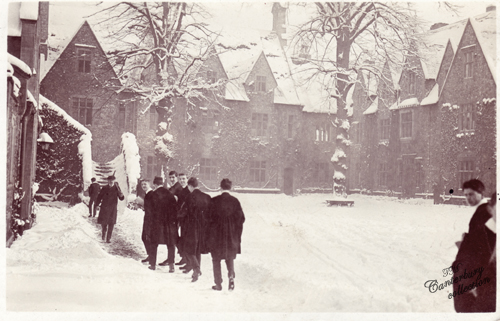
Kings School students c. 1909
1917
Kings School, The Precincts
Kings School (Junior), Palace Street
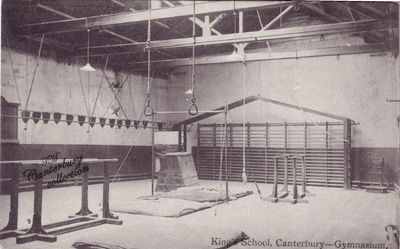
Kings School Gymnasium
TP April 5, 1924 - The steeplechase open to the day boys of the King's school, Canterbury, for the challenge cup offered by Mr. A. K. Mowll, took place on Monday and was won by Finn, son of Councillor P. R. Finn, of Canterbury.
TP April 5, 1924 - Dr. T. W. F. Gann, of Liverpool University, the eminent archaeologist and authority on Honduran antiquities, who, with Mr. F. Mitchell Hedges, the explorer, has discovered the ruins of a vast city in the heart of British Honduras, was educated at the King's School, Canterbury, whence he proceeded to the Middlesex Hospital. For his work in leading an expedition to relieve sufferers from the Guatemala earthquake he received thanks of the Colonial Secretary. Dr. Gann is a son of the late Mr. William Gann and a nephew of Mr. Henry Gann, J.P., of Whitstable.
